The evening started with John, G8DET welcoming Guests, Visitors & Members to the second Xmas Party. When everyone was seated Harry was invited to present the 3rd CARS Award to Jim, 2E1GUA.

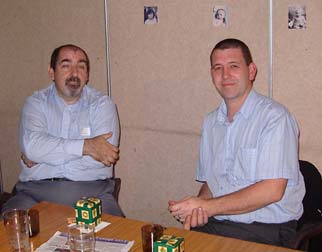
Jim Beatwell being presented with his CARS Award by President Harry, G5HF(left)
with James, M0ZZO, Chairman of Colchester ARS & Gary Cavie, M0JJH (right).
Photos by John with G4CTS's camera
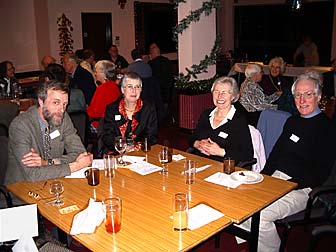

Geoff Bowles, Helen, Joan & Colin, G0TRM (left)
with Geoff, G3EDM in conversation (right).
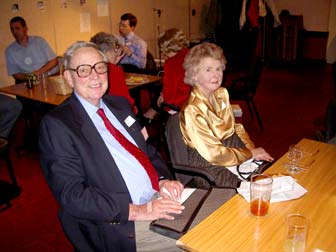
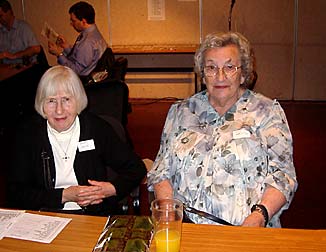
Vice President Charles, G0GJS & Ronnie (left)
with Betty (Wife of Ken Dews, G3PMW) & Ela, G6HKM (right)
<
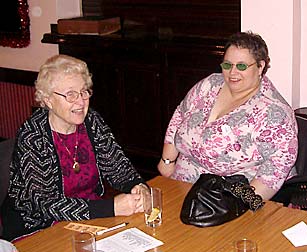
Patrick Xavier, M0XAP with his Wife, Anne Marie to his
right & to his left, Ken Dews, G3PMW
with Pam & Julie (G4CTS) (right)
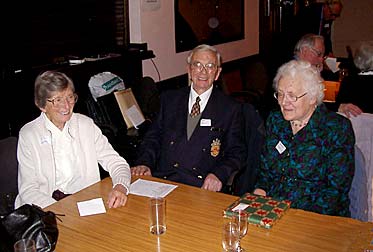
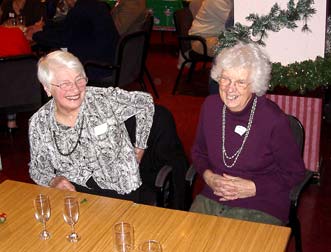
Ethel, Harry G5HF & Margaret Cockerill (left)
with Silvia (Wife of Geoff G3EDM) & Beryl (Wife of Fred G6FXM) (right)
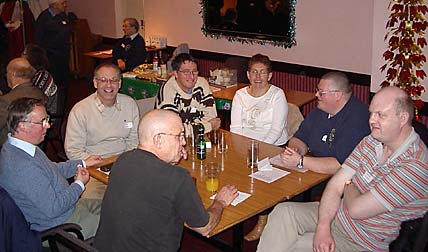
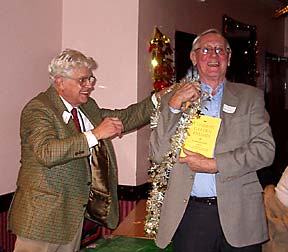
Group enjoying themselves (left)
with Geoff, G7KLV Buffet Organiser & Fred Wright G6FXM (right)
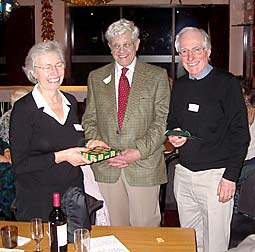
Joan, Geoff G7KLV & Colin G0TRM.
Joan & Colin working independently tied in the Baby
Photographic competition organised by Brian, G3CVI.
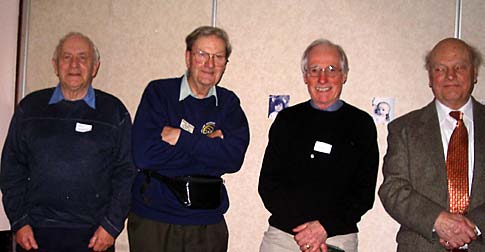
Ron, Brian, Colin & Denis standing in front of their photographs
when they were less than 1 year old.
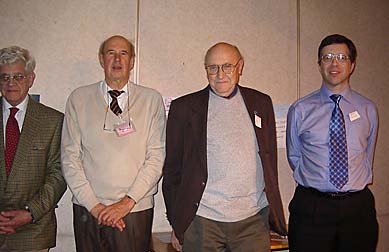
Geoff, John, Tony & Murray standing in front of their photographs
when they were less than 1 year old.
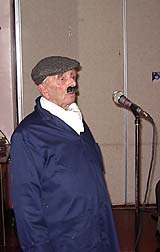
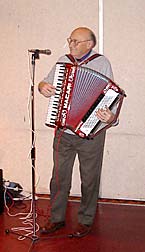
Harry giving a Monologue (left)
with Tony. G4YTG with his organ leading a sing-song (right)
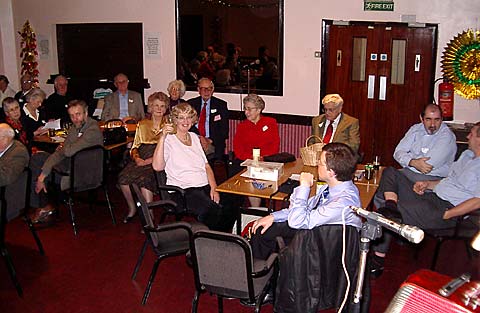
Group as seen by Tony leading the sing-song
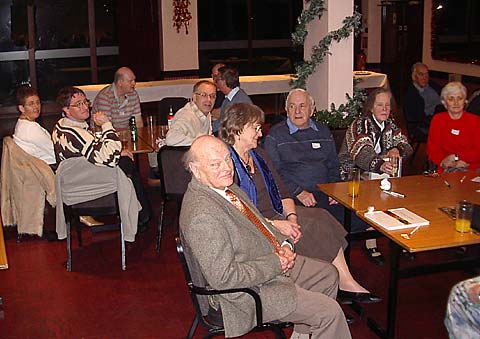
Left side of the Group as seen by Tony leading the sing-song

Pam & Brian, G3CVI who organised the Baby Competition
November Meeting - Rig Testing with Geoff Blake, G8GNZ
The evening started with Jim, 2E1GUA showing the large audience the actual shield he was presented with by the RSGB President, last month.

Jim Beatwell with his Contest Shield.
Photo by Colin, G0TRM
Both Nigel Hull & Malcolm Salmon were indisposed for the evening but fortunately, Geoff Blake, G8GNZ brought enough test equipment to check all the sets offered.
First of was John G8DET with a Kenwood TW4000 which was originally
purchsed by the late Roy Martyr, President.
Geoff checked its quality & power on 2metres & then 70cm - both OK.
John then had his first 70 cm QSO with Geoff.
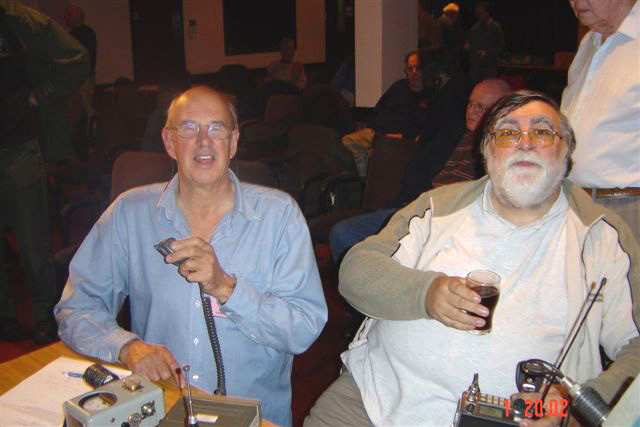
Chairman John, G8DET holding the microphone with
Geoff, G8GNZ who is having a well deserved drink.
Photo by Colin, G0TRM
Geoff then tested a number of rigs and adjusted the sensitivity/S-Meter on one.
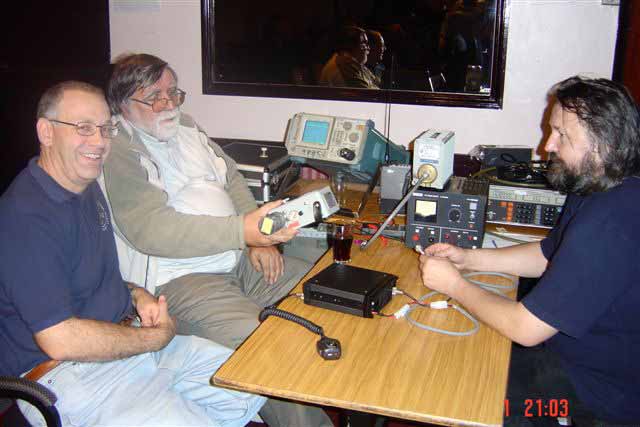
Geoff, G8GNZ testing another rig.
Photo by Colin, G0TRM
After Brian, G3CVI had booked people in and collected subscriptions (£10/year is now due), he set up a rig with the BHI Noise Reduction Unit which CARS has bought for Members to borrow.
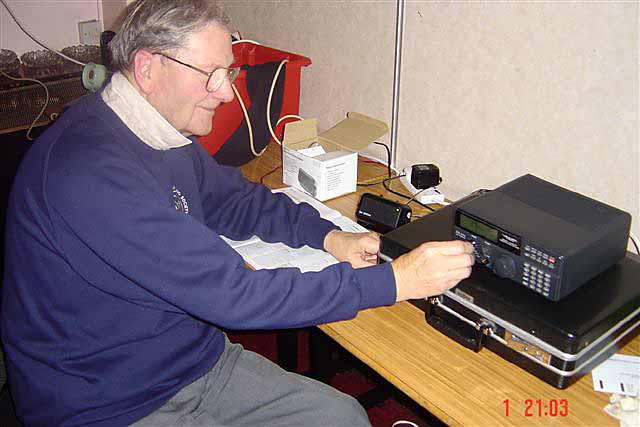
Brian, G3CVI demonstrating the BHI Noise Reduction Unit.
Photo by Colin, G0TRM
Unlike a simple filter, the unit takes a few moments to see what the Noise Floor is and then removes it leaving only the voice component. It was demonstrated on the Tannoy system and sounded very good - the louder the Noise Floor the more impressive the improvement.
Geoff was still testing rigs well after the superb Raffle was drawn - thank you Ron, M3CAM and nice to see your helper, your Wife, Ann.
It also was nice to see visitors from other Clubs including James McGinty, M0ZZO, Chairman from Colchester ARS & RSGB Deputy Regional Manager.
Thank you Geoff & Brian for all your good work & to Chris, G0IPU for arranging the evening.
September Meeting
Murray Niman, G6JYB presented "Antennas Live!!!"
The large audience gathered in the Marconi Clubroom with the seating laid out facing the windows as a change.

Chairman Chris, G0IPU introducing Murray
Photo by Trevor, M5AKA
Murray produced a laptop computer and digital projector that started with
a nice picture of the new Nimrod MRA4 aeroplane sprouting many antennas.
Murray said this was the stimulus for much of the software he was using -
his firm had to be able to demonstrate that the ~80 antennas did not
interfere with one another.
He then showed a crowded amateur radio mast with antenna covering HF to
UHF also all in close proximity with the comment "if only the owner knew
how each antenna affected the other and reduced the possible gain". One
sees this when one looks up on a chimney in Chelmsford with one TV
antenna pointing to London above and close to one pointing the opposite direction
towards Sudbury, net gain being rather random.
As Murray explained James Clerk Maxwell's Theory of Electromagnetic Waves has been around 150 years. Whilst the basic Laws of Physics haven't changed, the ability to understand and visualise them with computers has gone through a revolution. The advent of cheap PCs, powerful graphics and friendly user interfaces which take care of the maths for you has made an enormous difference.
Murray then proceeded to demonstrate just that in a sequence that followed Foundation Feeders & Antenna training.
A 3D model of a small length of 50 Ohm Coaxial Cable was first projected and the screen showed the electric fields flowing smoothly down it when terminated correctly. When deliberately mismatched by being joined to 90 Ohm Coax the standing wave was colourfully displayed on the 50 Ohm source side. Zooming up at the junction the audience could see the Electric-Field flux peaking on the corner of the discontinuity.
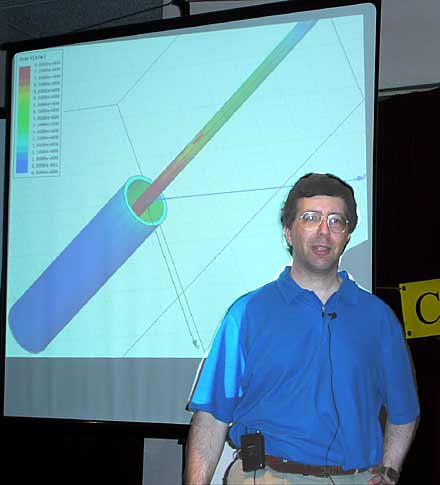
Murray with the projector showing the surface current on the outside of a coaxial Quarterwave antenna
(but without the benefit of Groundplane radials).
Photo by Trevor, M5AKA
Murray then showed a coaxial Quarterwave antenna (without radials) and showed the E-Field distribution up the coaxial cable to the tip of the antenna. When the plots of electric field and current were displayed a remarkable amount of energy was evident running back down the outside of the coaxial cable due the lack of a balun or Groundplane, see above.
To improve this Murray then added four radials to create a classic Quarterwave antenna and repeated the energy plots. Little energy then leaked back down the coaxial cable, and the radiation pattern was far cleaner, as shown below.
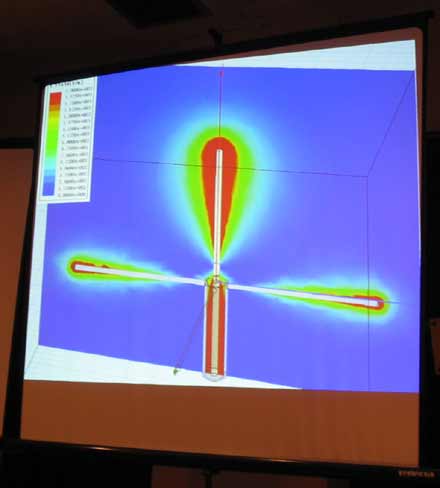
E-Fields on a full Quarterwave antenna (with Groundplane radials)
Photo by John, G8DET
A domestic TV 12-element Yagi antenna was next examined. A 3D diagram of its gain was projected showing the X-Axis with small lobes each side of the main lobe. Murray ran an animated sequence starting at Channel 21, 450MHz all the way up to 800MHz. As Murray increased the frequency so the gain changed and displayed the best front to back ratio at Ch5's frequency of about 600MHz. As the frequency approached Sudbury's so the display reverted to the poorer front to back situation. and far more prominent side-lobes. It was very enlightening to see in 3D a realistic plot of what is normally given as an ideal receiving antenna.
The next set of models included a two-storey house and garden. A
typical Amateur's shack in the upstairs room was next chosen for
attention with a long wire slung between the house and a pole down
the garden. The animated plot of this highlighted the main energy
going off the end (endfire), but with a significant backfire lobe
resulted in RF power going into the house, demonstrating how poor such
arrangements are for domestic EMC.
In response to a comment from the floor Murray said that the most
interesting aspect of this situation is to add the effect of power
cabling and hot water pipes, or the girders of office buildings -
something that could be done even in the freeware antenna programs.
Next a 6m antenna in the 1st floor shack window was tried which showed the main wave going skyward, but the lobe that hit good conducting ground hugging it for many metres.
A half wave 10m dipole was substituted halfway down the garden and the energy fields examined in detail. Now the antenna was fed with twin wire feeder and was therefore "balanced". This improved the energy patterns considerably. The higher and the further from the house & any possible trees, the better. The trade off being that this is not so good for local QSOs - better for long distance contacts.
Finally a flared waveguide horn was shown which demonstrated the wide aperture in the x-plane directing the energy well whilst the narrower vertical flare resulted in a large diffracted pattern which even crept back along the outside of the horn surface.
After a break and the excellent raffle with sixteen prizes, Murray projected a display of the free Software Controlled Radio decoder used on the SDR1000. The software is compatible with a new £17 kit that is tuned to 7.056MHz but could with skill (or a DDS) be changed. The software uses Microsoft .NET, so it needs to be used on a Windows 2000/XP computer with a reasonable sound card. It could resolve all current amateur modes except PSK31. "Spectrum, Waterfall & panoramic displays" were all shown.
Murray then went on to explain that many of the software packages used tonight were available as "Freeware". Other professional ones were also available, albeit with limited facilities, aimed at the education market with the hope that the student will become familiar with the product and then require his new employer to buy it for up to £30,000. As the maths is well known and graphics libraries are free he expects over time that ever more impressive facilities will appear in the freeware ones.
Some of the free software used included MMANA, MiniNec/Nec4Win, RFSim99, Agilent AppCAD, Sonnet-Lite. Many of these were already on Trevor' M5AKAs CD. More professional software with excellent colour graphics included FEKO and Ansoft HFSS. Animation Shop (part of Paintshop-Pro) can also produce nicely animated plots from several separate frames or screen snapshots.
A fascinating presentation on what every amateur had heard about, but had never seen before!
Thank you Murray.
Further info:
Dipole Side view - press+hold or right-click to set YouTube Loop mode
August Meeting - The Tabletop Sale by Colin, G0TRM.
Another August and this now Annual Club Table Top Sale has been one of the best with regards to the number of visitors and equipment which changed hands. At 7.15pm there was a good gaggle of eager people with money to spent so the "Gate Keeper", Brian G3CVI checked and found that the Tables were ready, so let the rush begin.
Those through the door were asked to sign on and then buy a
Raffle ticket (or 2).

Alex Dokic M3VAR and his Son Luke are seen here purchasing
their Raffle tickets from Chairman, Chris G0IPU and Ron, M3CAM
Photos by John, G8DET
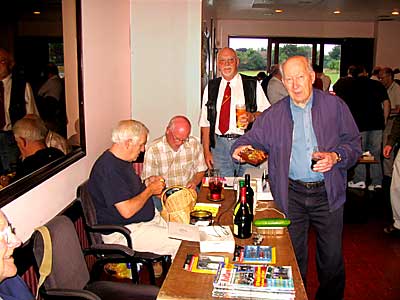
Ron (left preparing Raffle tickets) next is Bob Hastings 2E0BOB,
Zipy, G4ZPE holding a drink, John Peters G3VML is on the right
Our well known Dengie visitor Zipy, G4ZPE was again much in evidence, he had many happy customers at his table vying for all sorts of goodies from the depths of the Waters and Stanton store. He was pleased to have completly sold out by 8.45pm.
A number of new Stall Holders were selling various test equipment, now doubt as part of a "shed clearout".
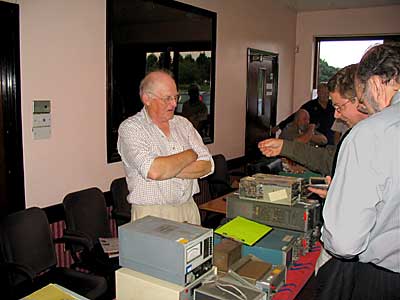
Graham Tickle with his stall of Test Equipment
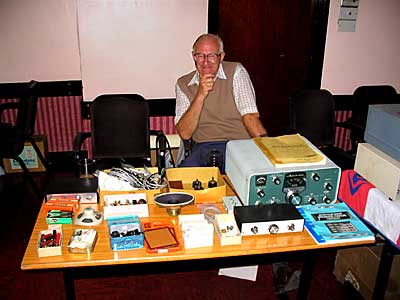
Classic Heathkit Receiver for sale.

Dave Penny, G3PEN brought trays of meters
as well as plenty of LEDs on PCBs
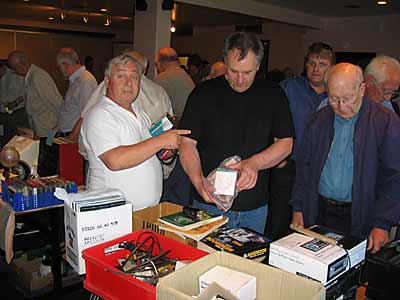
The Stall of Geoff Lovegrove, G7KLV with many different
items for sale. Left & centre are Visitors with John Peters G3VMJ on the right.
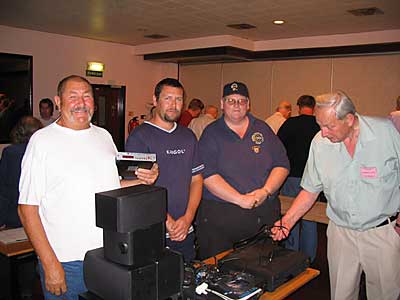
Vice President Charles Shelton, G0GJS (right) looking at
a collection of Video Recorders for sale by John Palmer, M0CQK
(centre), his Father, Bill 2E0GVX to the left & Jim Beatwell,
2E1GUA to the right.
Jim is very well known for his success in Contests.
Thanks to all the Club Members who came along to sell, to buy or just to have a look and to exchange views with others. Thanks of course to the Stewards and others who played their part in helping to make it a very successful evening.
Dereck Mayes set up a very good table loaded with Prizes of a Raffle with the proceeds going to the Colchester and Chelmsford Hospices.
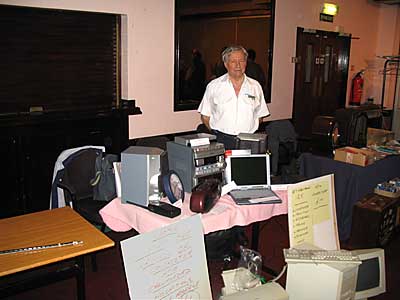
Hospice Raffle table
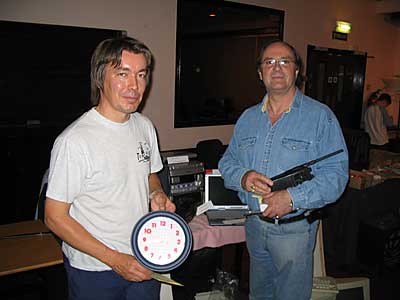
Two of the many Hospice Raffle winners with Mr Butterworth on the right.
CARS President Harry, G5HF & Ethel also had a Table for the Chelmsford Hospice which did a brisk trade.
Whilst all this brisk business was going on, Murray, G6JYB had a corner of the room with a video projector displaying the lastest saga in the Ofcom Story.
Tony Blair's past Media mogo, Mr Ed Richards has now got the job of
running (down) Ofcom.
With this in mind he has paid Prof Cave to prepare Papers which
support the idea that the
Government can make a lot of money selling off Radio Spectrum.
A number of "Consultation Documents" have been issued to which
CARS and it's Members have
replied to every one. No other person or organisation has done
this - we have Murray to thank
for drawing our attention to what is going on.
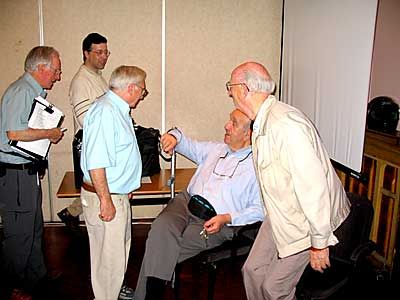
Murray G6JYB & his Ofcom presentation which caused quite a debate.
From left to right. Colin G0TRM; Murray G6JYB; Malcolm G4KGL;
Fred Leach G2HFN & Peter Graves G0KSJ.
July Meeting - Arnhem - A Contact Too Far by Tom Robinson G0SBW
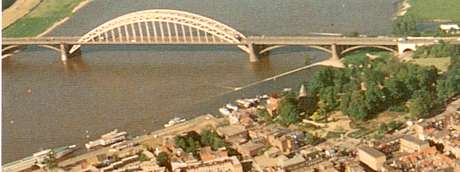
The Bridge at Nijmegen
The above photograph shows a modern version of the bridge which featured in the Arnhem based film "A Bridge Too Far" which recounted the story of the largest airborne operation ever, to date, with some 35,000 troops, 430 aircraft and all the logistics that pertained and put together in a few weeks.
It was called "Operation Market Garden" and led to the liberation of this part of Holland on 17th September 1944 after fierce fighting.

Tom Robinson presenting his Lecture to CARS
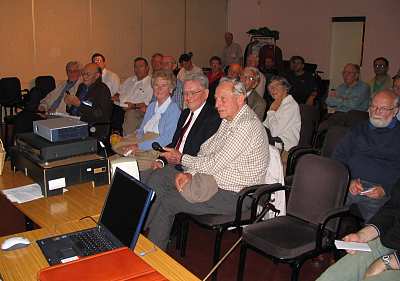
CARS Members with Mr David Dagwell of Danbury (black jacket)
who was in Operation Market Garden.
Seated with him is Vice President Charles Shelton, G0GJS and his Wife, Ronnie.
The TV Documentary people from Granada were going to make one of their "Battlefield Detectives" series and look into the communication difficulties experienced in this Operation. The technical adviser, Dr. Austin G0GSF, knew of Tom's exploits and asked him if he would be able to give them the benefit of his experience and assistance in the actual tests.
They wanted to test the actual sites and, as far as possible, the conditions to answer the following communication problems which arose on the actual operation.
- Was it the operators,
- was it the equipment,
- was it the terrain or
- was it the frequencies used?
Tom didn't need much persuasion, and in the short time available before the days allocated to the filming on site, pressed his friend Peter G8BLS into service to develop another backpack as two stations were obviously required. Tom already had his own gear in the shape of an IC703. ICOM very kindly lent another set to do the tests.
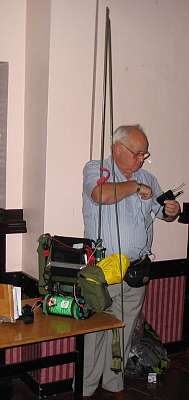
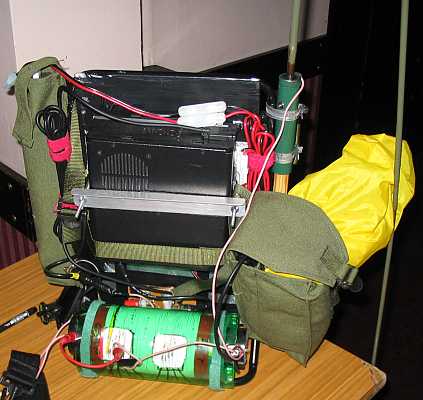
Tom Robinson and a close-up of the TS703 backpack.
Wireless Sets 68Ps were the sets originally used on frequencies around 2.2MHz using 11ft whip aerials, and AM at 0.25W on the lower end of the band and 1 W at the higher end. Although a few of these sets are still in museums and military establishments there were none in working order that could easily be obtained for use. The WS68Ps are valved receivers and transmitters using dry batteries for HT and filament supply.
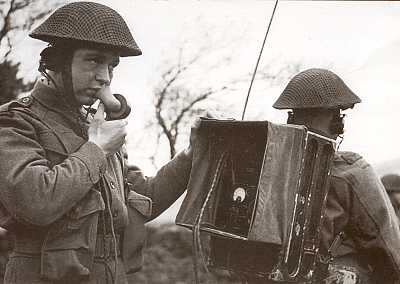
The Army using a 68 Set, note the whip aerial
The IC703s were calibrated to produce similar power and the aerials were bottom loaded with a coil to get them on tune. No earth spikes were allowed as in 1944 the sets were used very much "on the move".
Before they set off to do the filming Tom and Peter carried out a series of tests to check that the gear would work and imitate the performance of the WS68Ps. They discovered that with the base loading coil shorted, the whip would tune nicely to 6m and using FM (and higher power) they were able to use this as a very reliable communication method over all the sites both for their own (and the film crews use although this was not part of their remit).
They set off with confidence that the gear was a fair copy in performance and the distances covered would not be a problem.
Tom showed an extract from the film which took about seven minutes but took over a day to film. It was all done in wet conditions making them glad they had made waterproofing for the rigs, but with admiration for the film crew who took it all in their stride.
Some Dutch radio amateurs turned up with a working WS68P. This was compared with the IC703's and gave comparable performance and was the one shown in the film for authenticity. The tests showed clearly that the range expected from the WS68P was not attained even using the modern rigs. Some of the actual sites were okay over short paths and open country but as soon as the forested areas were encountered no communication was possible.
Tom said that he thought that little was known about propagation conditions in wooded areas on MF but, since the event, he has met people who said "we knew it would not work" and others who quoted the MF broadcasters and said they do alright with long wire aerials but not with Whips on a WS68P and with only 0.25 or 1 watt!
Tom has done an extensive amount of research into both the materiel (look it up) for the Arnhem battle and the reasons for using the sets that were chosen. Tom put over his story in an interesting manner and gave us his conclusions which came over to me as follows:-
a) The operators did not stand a chance with the WS68P at the
frequencies used and over the wooded areas encountered.
b) The drop zone was badly chosen and they ended up too far away from the
target (the Arnhem bridge). When the plan was made and the glider loads
were arranged higher power radio sets were not required as the
expected ranges were not heavily wooded and well within the gear provided.
Thanks Tom (and Pete) for giving us the information on your findings and letting us draw our own conclusions.
After the Meeting CARS has heard of Army Radio Operators using temporary Long Wire Aerials, Earth Spikes with their 68 Sets, making reliable contact over 100 miles, even in wooded areas.
Report by Tony G4YTG.